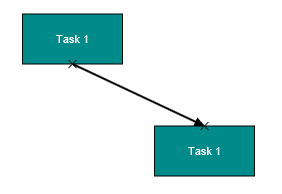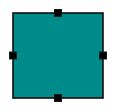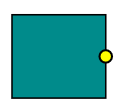Port in JavaScript Diagram
18 Jan 20235 minutes to read
Essential Diagram for JS provides support to define custom ports for making connections.

When a connector is connected between two nodes, its end points are automatically docked to node’s nearest boundary as shown in the following image.

Ports act as the connection points of node and allows to create connections with only those specific points as shown in the following image.

Create Port
Add ports when initializing nodes
To add a connection port, you need to define the port object and add it to node’s ports collection. The offset property of port accepts an object of fractions and used to determine the position of ports. The following code illustrates how to add ports when initializing the node.
var nodes = [{
width: 100,
height: 100,
// Defines a collection of ports
ports: [
//Defines JSON to create port
{
//Sets the port name
name: "port1",
// Specifies the port offset – fraction value relative
to node bounds
offset: {
x: 0,
y: 0.5
},
}]
}];
$("#diagram").ejDiagram({
// Sets the nodes to Diagram model
nodes: nodes,
});Add ports at runtime
You can add ports at runtime by using the client side method addPorts. The following code illustrates how to add ports to node at runtime.
- The port’s name property is used to define the name of the port and its further used to find the port at runtime and do any customization.
// Defines a collection of ports that have to be added at runtime
var ports = [
{
name: "port1",
// Specifies the port offset – fraction value relative
to node bounds – determines the position of port on node
offset: {
x: 0,
y: 0.5
}
},
{ name: "port2",offset: {x: 1,y: 0.5 }},
{ name: "port3",offset: {x: 0.5,y: 0 }},
{ name: "port4",offset: {x: 0.5,y: 1 }}
];
// Gets the instance for the Diagram
var diagram = $("#diagram").ejDiagram("instance");
// Adds the ports to the node of name "node"
diagram.addPorts("node", ports)
To explore the set of properties for defining a port, refer to Port Properties
Remove ports at runtime
You can remove ports at runtime by using client side method removePorts. Please refer to below link which shows how to remove ports at runtime.
Update Port at runtime
The client side API updatePort is used to update the ports at run time. The following code example illustrates how to change the port properties.
var diagram = $("#diagram").ejDiagram("instance");
var selectedObject = diagram.model.selectedItems.children[0];
var visibility = ej.datavisualization.Diagram.PortVisibility.Visible;
diagram.updatePort(selectedObject.name, selectedObject.ports[0], { fillColor: "red", visibility: visibility });Connect with ports
Connector’s sourcePort and targetPort properties allow to create connections between some specific points of source/target nodes.
For more information about creating connections with port, refer to Connections with ports
Appearance
-
You can change the shape of port by using its shape property. To explore the different types of port shapes, refer to Port Shapes. If you need to render a custom shape, then you can set shape as
pathand define path using pathData property of port. -
The appearance of ports can be customized by using borderColor, borderWidth, fillColor properties of the port.
-
To customize the port size, use size property of port.
-
The ports visibility property allows you to define when the port should be visible.
-
The cssClass property used to customize the style of port using user defined CSS class.
The following code illustrates how to change the appearance of port.
var ports = [{
// Specifies the port position
offset: {
x: 1,
y: 0.5
},
//Defines the shape of port
shape: ej.datavisualization.Diagram.PortShapes.Circle,
//Specifies the port visibility
visibility: true,
//Customizes the appearance
fillColor: "yellow",
size: 12,
borderColor: "black",
borderWidth: 2
}];
var nodes = [{ name: "node", ports: ports }];
Offset
The offset property of port is used to align the port based on fractions. 0 represents top/left corner, 1 represents bottom/right corner, and 0.5 represents half of width/height.
Constraints
The constraints property allows to enable/disable certain behaviors of ports. For more information about port constraints, refer to Port Constraints